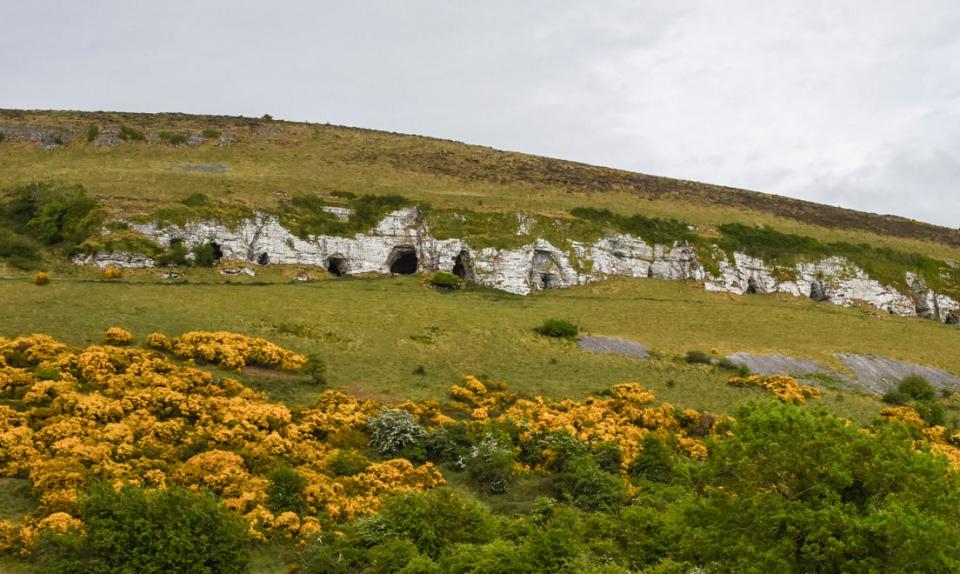How Ireland gave birth to Halloween

The Keshcorran Mountain caves were seen as portals to the ‘otherworld'
(Ronan O’Connell)At the end of a bumpy road, in the middle of an Irish field, I find a cramped entrance to a small cave. This is not what I expected of a so-called “gate to hell”, but a nearby sign confirms this is indeed the location where Halloween was born 2,000 years ago.
These days, Oweynagat cave in County Roscommon is a nondescript, little-visited hole in the ground. To Ireland’s ancient ancestors, however, it was an important place which, once a year, acted as a passage between the mortal world and the otherworld, a subterranean land occupied by powerful spirits.
On 1 November each year, Pagan Celts would gather at auspicious locations like Oweynagat to perform rituals around a bonfire while waiting for the brief moment when the invisible wall between these worlds dissolved. This was the festival of Samhain, which marked the Celtic New Year and many centuries later morphed into Halloween.
It would be easy to assume Halloween originated in the United States, which has helped spread its popularity across the world via depictions in film and television. But in fact, the festival, whose name derives from “Hallowed Evening”, was introduced to the US in the 1800s by Irish immigrants.
In Ireland it’s not just a kitschy holiday when children dress up as ghouls to collect sweets. Rather, it’s a time when, according to Irish mythology, the country’s most notorious caves emerge from hibernation. Known as gates to hell, sites like Oweynagat and Keshcorran in County Sligo are believed to become temporary portals to the otherworld.
Legend has it that during Samhain, mortals could enter the fairy world and vice versa, according to Irish folklore expert and associate professor at Canada’s McGill University, Dorothy Bray. “Samhain was a time charged with great supernatural energy and ordinary natural laws were suspended,” she says. “The idea of the otherworld developed into the idea of the afterlife, so Samhain became a time when the worlds of life and death meet, when the souls of the dead return and can be seen.”
Samhain featured heavily in early Irish literature, according to Dr Kelly Fitzgerald from the School of Irish, Celtic Studies and Folklore at University College Dublin. She says the brief disappearance of the walls separating Ireland’s two worlds during Samhain aided the Celtic practice of divination, or fortune telling.

Considered the chief portal between these worlds, Oweynagat has long been linked to the birth of Samhain. Visitors small enough to squeeze through Oweynagat’s tight entrance will find a narrow, 37m-long cave partly paved by ancient stone slabs, some of which bear Ogham (Old Irish language) inscriptions up to 1,500 years old. Being 6ft5 and heavily built, and with no-one around to help me in case of an accident, I decided not to descend into Oweynagat and to instead explore the roomier Keshcorran caves, 30km to the north.
Compared to the largely-ignored Oweynagat, these mountainside caves are popular with tourists and locals. Their spectacular perch on Keshcorran Mountain is a key selling point. I walked through a grassy field and up a steep incline decorated by golden wildflowers before reaching these caves, which offer panoramic views across the farms, lakes and hills of Sligo, one of Ireland’s most idyllic counties.

Shaped like giant doorways cut into the limestone mountain, it’s easy to understand why ancient Celts saw these 16 caves as entrances to the otherworld. According to some myths, Keshcorran is a gate to hell that connects with Oweynagat cave.
While Oweynagat seemed to me, at first glance, to be randomly positioned in farmland, it is in fact part of Europe’s biggest and oldest unexcavated royal site. Called Rathcroghan, this is believed to have been the capital of Ireland’s Connachta dynasty more than 2,000 years ago. Spread over an area of about 2.5 square miles are 240 archaeological sites, dating back 5,500 years in some cases, including a cluster of ring forts, standing stones and prehistoric burial mounds.
Among these tombs is that of Queen Medb who, according to Irish mythology, was born in the depths of Oweynagat cave. This dark space is also said to have been inhabited by an even more fearsome woman: the war goddess of the otherworld, Morrigan, a shape-shifting spirit who took the form of a crow and used Oweynagat to enter Ireland and wreak havoc.
Fortunately, I saw no sign of this menacing ghost when I got on my knees and peered into the abyss of Oweynagat. Nor did I encounter Cormac mac Airt at Keshcorran caves, inside which this legendary Irish king is said to be in slumber, waiting for the day his country needs to be saved.
It’s funny to think that on 31 October, millions of children around the world will celebrate Halloween, completely unaware they’re continuing a tradition that began 2,000 years ago in an Irish cave.
Read more


